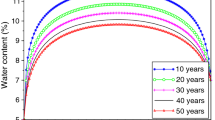Abstract
Buildings are often composed of materials with a porous structure. Moisture in the masonry has a destructive impact caused by cycles of drying–wetting and freezing–thawing. A new sensor principle for monitoring moisture in the masonry is presented herein. This sensor utilizes changes in the thermal conductivity of porous structures when they are filled with moist air, water, or ice depending on the existing thermodynamic conditions. Herein, the “hot-ball” method is used to measure the thermal conductivity. The moisture sensor is prepared for porous material corresponding to the parent material, whether it is rock, brick, or concrete. This parent sample is taken from a borehole drilled into the wall. Methodology for moisture sensor calibration is also presented. Sensors were placed in the masonry walls of St. Martin’s Cathedral tower in the North, South, and West orientations. The sensors were placed in the plaster and bricks at depths up to 60 mm in the wall surface, just below the window sill. The temperature–moisture regime was monitored from August 19th, 2011 to March 30th, 2012. Changes in temperature and moisture were then correlated with meteorological data.








Similar content being viewed by others
References
Bayosan B (2012) Technical data sheet. http://www.greenspec.co.uk/building-products/exterior-wall-renders-coatings/
Brüggerhoff S, Wange G, Morat P, Le Mouël JL, Perrier F (2001) Firstresults of using combined mass and temperature measurements to study the water flow at the rock–atmosphere interface. J Cult Heritage 2:117–132
Campbell GS, Calissendorff C, Williams JH (1991) Probe for measuring soil specific heat using a heat-pulse method. Soil Sci Soc Am J 55:291–293
Carslaw HS, Jaeger JC (1956) Conduction of heat in solids. Clarendon Press, Oxford, p 348
Fidrikova D (2012) Role of water in porous structure. PhD thesis, Institute of Physics SAS, Bratislava (in Slovak)
Gummerson RJ, Hall C, Hoff WD, Hawkes R, Holland GN, Moore WS (1979) Unsaturated water flow within porous materials observed by NMR imaging. Nature 281:56–57
Koronthalyova O, Matiasovsky P (2007) Pore structure and thermal conductivity of burnt clay bricks. In: Jozef L (ed) Proceedings of meeting of the Thermophysical Society, Kocovce 2007, STU, Bratislava, p 100. http://www.fch.vutbr.cz/lectures/thermophysics/2007/
Kramer MA, Graham Finch K, Hubbs B, Teetaert J (2006) Monitoring of historic structures for whole-building improvements. In: Proceedings from the third international building physics conference, Montreal, Quebec, 27–31 August 2006. http://www.ornl.gov/sci/buildings/2012/B11%20papers/142_Kramer.pdf
Kubičár Ľ, Vretenár V, Boháč V, Tiano P (2006) Thermophysical analysis of sandstone by pulse transient method. Int J Thermophys 27:200–234
Kubičár Ľ, Vretenár V, Štofanik V, Boháč V, Tiano P (2008) Monitoring of thermal moisture regime of cultural objects. In: Proceedings of conference: in situ monitoring of monumental surfaces—SMW08, Florence, pp 53–62
Kubičár Ľ, Vretenár V, Štofanik V, Boháč V (2010) Hot-ball method for measuring thermal conductivity. Int J Thermophys 31:1904–1918
Maxwell JC (1904) A treatise of electricity and magnetism, vol 1, 3rd edn. Oxford, Clarendon, p 440
Phillipson MC, Baker PH, Davies M, Yeb Z, McNaughtana A, Phil M, Galbraith GH, McLeanc RC (2007) Moisture measurement in building materials: an overview of current methods and new approaches. Build Serv Eng Res Technol 28:303–316
Phillipson MC, Baker PH, Davies M, Ye Z, Galbraitha GH, McLeanc RC, Phil M (2008) Suitability of time domain reflectometry for monitoring moisture in building materials. Build Serv Eng Res Technol 29:261–272
Plagge R (2003) Bestimmung von Materialfeuchte un Salzgehalt in kapillar porosen Materialien mit TDR, Kolloquium mit Workshop Innovative Feuchtemessung und Praxis, Karlsruhe, 3–4 July 2003
Roels S, Carmeliet J, Hens H, Adan O, Brocken H, Cerny R, Pavlik Z, Ellis AT, Hall C, Kumaran K, Pel L, Plagge R (2004) A comparison of different techniques to quantify moisture content profiles in porous building materials. J Thermal Env Bldg Sci 27:261–276
Said MN (2004) Moisture measurement guide for building envelope applications, National Research Council, Canada, Research report #190, August 20, 2004. http://www.nrc-cnrc.gc.ca/obj/irc/doc/pubs/rr/rr190/rr190.pdf
Sass O, Viles HA (2006) How wet are these walls? Testing a novel technique for measuring moisture in ruined walls. J Cult Heritage 7:257–263
Acknowledgments
The authors thank M. Markoviè and I.Peller for their technical assistance. Special thanks is also due to the Bratislava Archdiocese, especially to Mons. Thurzo for his help and kindness during this demonstration experiment. This work was supported by the Slovak Research and Development Agency under contracts No. LPP APVV 0442-09, No. APVV-0330-10 and No. APVV-0641-10.
Author information
Authors and Affiliations
Corresponding author
Rights and permissions
About this article
Cite this article
Fidríková, D., Greif, V., Dieška, P. et al. Monitoring of the temperature–moisture regime in St. Martin’s Cathedral tower in Bratislava. Environ Earth Sci 69, 1481–1489 (2013). https://doi.org/10.1007/s12665-012-2160-7
Received:
Accepted:
Published:
Issue Date:
DOI: https://doi.org/10.1007/s12665-012-2160-7




